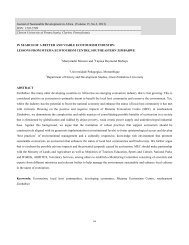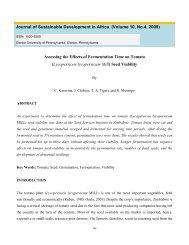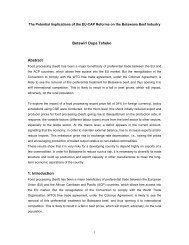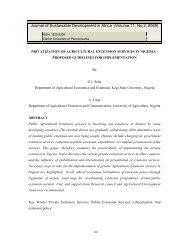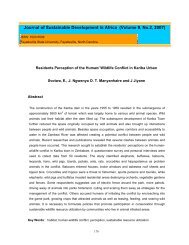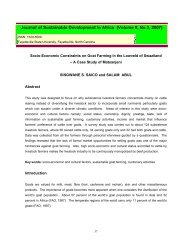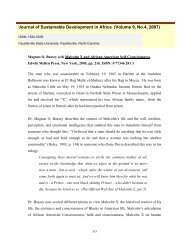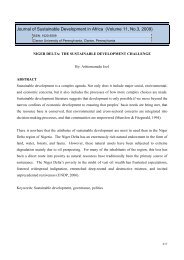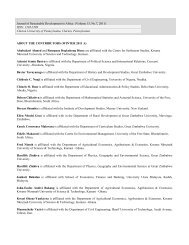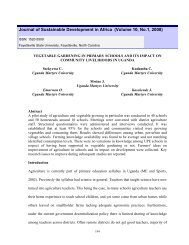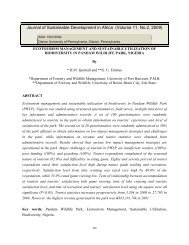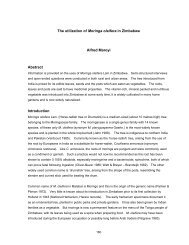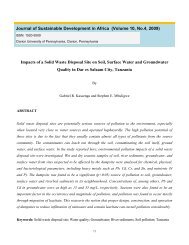Access to Safe Drinking Water by Rural Communities in Zimbabwe
Access to Safe Drinking Water by Rural Communities in Zimbabwe
Access to Safe Drinking Water by Rural Communities in Zimbabwe
You also want an ePaper? Increase the reach of your titles
YUMPU automatically turns print PDFs into web optimized ePapers that Google loves.
INTRODUCTION<br />
The world faces severe and grow<strong>in</strong>g challenges <strong>to</strong> susta<strong>in</strong> water quality and <strong>to</strong> meet the rapidly grow<strong>in</strong>g<br />
demand for water resources, particularly among rural communities <strong>in</strong> Africa and <strong>Zimbabwe</strong>. This is<br />
despite the efforts (through the Integrated <strong>Rural</strong> <strong>Water</strong> Supply and Sanitation Programme) <strong>by</strong> the<br />
<strong>Zimbabwe</strong> Government and the donor community <strong>to</strong> improve the availability of safe dr<strong>in</strong>k<strong>in</strong>g water <strong>to</strong><br />
rural communities as an important policy matter s<strong>in</strong>ce the 1980s. With <strong>in</strong>creas<strong>in</strong>g population water<br />
demand <strong>in</strong> Africa and <strong>Zimbabwe</strong> cont<strong>in</strong>ue <strong>to</strong> rise and present challenges <strong>to</strong> the supply of water <strong>to</strong> rural<br />
communities. Critical determ<strong>in</strong>ants <strong>to</strong> this scenario <strong>in</strong>clude distance <strong>to</strong> the water po<strong>in</strong>t, polluted water<br />
sources, perennial droughts, depleted ground water sources, and poorly formulated water and sanitation<br />
policies. Given this scenario, it was imperative that a deeper understand<strong>in</strong>g of the dynamics of access <strong>to</strong><br />
water <strong>in</strong> the rural environment were explored with the view <strong>to</strong> <strong>in</strong>fluence policy. To achieve this, the<br />
paper exam<strong>in</strong>es the sources of water, access <strong>to</strong> water <strong>by</strong> households, constra<strong>in</strong>ts <strong>to</strong> the provision of safe<br />
dr<strong>in</strong>k<strong>in</strong>g water, and the related environmental health implications of unsafe dr<strong>in</strong>k<strong>in</strong>g water. Micro scale<br />
studies of this nature are critical <strong>in</strong> identify<strong>in</strong>g environmental health risks associated with the cont<strong>in</strong>ued<br />
limited access <strong>to</strong> safe dr<strong>in</strong>k<strong>in</strong>g water <strong>in</strong> the rural areas of <strong>Zimbabwe</strong>. This was done on the assumption<br />
that the rural water provision programme has not met the desired targets of safe and readily accessible<br />
water <strong>to</strong> rural households.<br />
LITERATURE REVIEW<br />
<strong>Access</strong> <strong>to</strong> <strong>Water</strong> and Consumption Patterns among <strong>Rural</strong> <strong>Communities</strong><br />
<strong>Access</strong> <strong>to</strong> water entails be<strong>in</strong>g with<strong>in</strong> safe physical reach, be<strong>in</strong>g affordable, accessible <strong>in</strong> law and <strong>in</strong> fact<br />
<strong>in</strong>formation on water issues be<strong>in</strong>g provided (UN, 2003). Reasonable access, thus, is the availability of at<br />
least 20 liters of water per person per day from a source with<strong>in</strong> one kilometer of the homestead (WHO,<br />
needs date). Improv<strong>in</strong>g access <strong>to</strong> water has been the thrust of most governments, UN agencies, and<br />
many different organizations but these have failed <strong>to</strong> satisfy demand <strong>in</strong> the shortest time. The water<br />
supply and sanitation coverage for Africa rema<strong>in</strong>s the lowest at 62% and 60% respectively<br />
(WHO/UNICEF/WSSCC, 2000). This contrasts the coverage <strong>in</strong> <strong>Zimbabwe</strong>, which has decl<strong>in</strong>ed <strong>to</strong> 30%<br />
<strong>in</strong> the last eight years ow<strong>in</strong>g <strong>to</strong> a host of fac<strong>to</strong>rs, <strong>in</strong>clud<strong>in</strong>g destruction of <strong>in</strong>frastructure <strong>by</strong> Cyclone<br />
El<strong>in</strong>e, frequent droughts, and f<strong>in</strong>ancial challenges. Thus, more than 75% of <strong>Zimbabwe</strong>'s population of<br />
12.5 million people cont<strong>in</strong>ues <strong>to</strong> live under water stressed conditions <strong>in</strong> most rural areas.<br />
114



